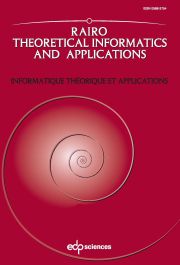No CrossRef data available.
Article contents
An improved derandomized approximation algorithmfor the max-controlledset problem
Published online by Cambridge University Press: 28 February 2011
Abstract
A vertex i of a graph G = (V,E) is said to be controlled by $M \subseteq V$ if the majority of the elements ofthe neighborhood of i (including itself) belong to M. The setM is a monopoly in G if every vertex $i\in V$
if the majority of the elements ofthe neighborhood of i (including itself) belong to M. The setM is a monopoly in G if every vertex $i\in V$ iscontrolled by M. Given a set $M \subseteq V$
iscontrolled by M. Given a set $M \subseteq V$ and two graphsG1 = ($V,E_1$
and two graphsG1 = ($V,E_1$ ) and G2 = ($V,E_2$
) and G2 = ($V,E_2$ ) where $E_1\subseteq E_2$
) where $E_1\subseteq E_2$ , themonopoly verification problem (mvp) consists of decidingwhether there exists a sandwich graph G = (V,E) (i.e., a graphwhere $E_1\subseteq E\subseteq E_2$
, themonopoly verification problem (mvp) consists of decidingwhether there exists a sandwich graph G = (V,E) (i.e., a graphwhere $E_1\subseteq E\subseteq E_2$ ) such that M is a monopolyin G = (V,E). If the answer to the mvp is No, we thenconsider the max-controlled set problem (mcsp), whoseobjective is to find a sandwich graph G = (V,E) such that thenumber of vertices of G controlled by M is maximized. The mvp can be solved in polynomial time; the mcsp, however, isNP-hard. In this work, we present a deterministic polynomial timeapproximation algorithm for the mcsp with ratio$\frac{1}{2}$
) such that M is a monopolyin G = (V,E). If the answer to the mvp is No, we thenconsider the max-controlled set problem (mcsp), whoseobjective is to find a sandwich graph G = (V,E) such that thenumber of vertices of G controlled by M is maximized. The mvp can be solved in polynomial time; the mcsp, however, isNP-hard. In this work, we present a deterministic polynomial timeapproximation algorithm for the mcsp with ratio$\frac{1}{2}$ + $\frac{1+\sqrt{n}}{2n-2}$
+ $\frac{1+\sqrt{n}}{2n-2}$ , where n=|V|>4. (Thecase $n\leq4$
, where n=|V|>4. (Thecase $n\leq4$ is solved exactly by considering the parameterizedversion of the mcsp.) The algorithm is obtained through theuse of randomized rounding and derandomization techniques based onthe method of conditional expectations. Additionally, we show howto improve this ratio if good estimates of expectation are obtained in advance.
is solved exactly by considering the parameterizedversion of the mcsp.) The algorithm is obtained through theuse of randomized rounding and derandomization techniques based onthe method of conditional expectations. Additionally, we show howto improve this ratio if good estimates of expectation are obtained in advance.
Information
- Type
- Research Article
- Information
- Copyright
- © EDP Sciences, 2011

